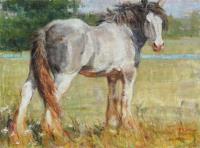
John Austin Hanna
Growing up in Beaumont, Texas, John discovered his love of art early in life. “My first memories of drawing are when I was 5 years old. I was in the hospital, and my mom brought me paper and pencils. And, I remember there was nothing to do but draw. Ever since then, that’s what I’ve always liked to do.”
John’s seventh-grade history teacher believed in his talent. She was the first person to purchase a painting from the budding artist. She paid $10 for a watercolor of his grandfather’s chicken yard.
John continued to pursue art at Texas Tech University, where he graduated in 1964 with a bachelor’s degree in advertising art and design. He immediately left Texas for the bright lights of New York City. He found work quickly at Ted Bates Advertising, at the time one of the largest agencies in the world. John continued his painting as an illustrator with many illustrations for magazines such as Argosy, Town & Country, Car & Driver, Popular Boating, Automobile Quarterly, and many others. After six years in New York he had the opportunity to return to Texas in a partnership with Tracy Locke Advertising in Dallas.
“One day I realized that I was moving further away from what I really wanted to do – painting,” said John. “I quit my job and began freelancing as an illustrator.” His quest to fulfill his lifelong dream of becoming a full-time painter led him back to Texas. He and his wife, Sherry, moved to Dallas and, in 1978, they eventually found their way to Fredericksburg. hat year they “made that fateful drive through Fredericksburg on the way to Big Bend and fell in love with the historical feel of the city, which reminded us of the northeast,” he relates. “I bought a 1978 red pickup that we used to transport our home and embarked on a new direction.” It was a good move. John painted prolifically, and his stature as an artist grew.
He still drives that red pickup today. “In 1978, Fredericksburg wasn’t the tourist destination and retirement community it is today,” he explains. “For several years I worked in two rooms over Dooley’s Five and Dime, and later in a small house. I built my current studio behind our home in 1998, part of which is a sitting area and library. I have hundreds of books, more than 10 of which are on John Singer Sargent and his artist-friend Antonio Mancini. Richard Schmid and James Reynolds are two of my favorite contemporary artists – their drawing skills are solid and their brushwork fresh and not labored.”
John occasionally travels to places such as San Miguel de Allende in Mexico in search of resource material for paintings such as “Water Girl.” However, he gets just as much pleasure driving through the Hill Country back roads that surround his home town. “I get up early, grab a cup of coffee and head out with my camera to see what’s new. The world around us if filled with everyday places that have so much character. I never tire of its variety.”
One of John’s greatest talents is the ability to capture the essence of a moment so swiftly lost in the blink of an eye. He integrates his imagination and humor into every scene he paints. His scenes depict a delicate balance of composition, space and light, enabling onlookers to image being in the scene.
It often has been said that art is a reflection of culture. Without its existence, the sights and feelings of previous generations would be lost. John’s work reflects the settings, moods, and tranquility found in the places he has been.
John did not set out to be a historian of the area, nonetheless he has become one. The man in “Honest Day’s Work” is local resident Fred Whitewood III. “His family goes back three generations in Fredericksburg. When I met Fred 30 years ago, he was tending bar and has always been a jack-of-all-trades. The land and people here mean a lot to me,” John reflects. “In the past two decades, I’ve chronicled a lot of change, but it’s been my joy to record it for future generations.”